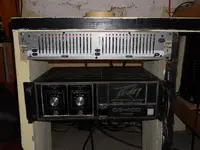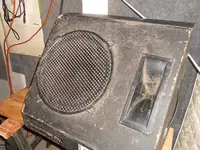R
rockironwebb
senior newbie caveman
My bassist got a hold of a dinosaur power amp and a couple of before Christ speakers.
Photo included. Even though the amp looks like it has seen better days it works well and is sufficient for our practice needs. I have hooked the amp up to a 4x12 cabinet and it runs a signal very well. The speakers the came in the deal completely suck!!! They are old and Sound absolutely muddy and I would rather not waste my electricity even hooking them up. I am the drummer of this outfit and since I have the practice space, I am by default, "The keeper of the Gear". I don't mind this at all.
Question NOW!!!!!
I am now willing to either buy a set of PA speakers that are worth using, or if more cost effective, purchase replacement speakers and stick them in the old boxes.
I have read a little about watts, ohms and such but I am a little confused about what should be used to power what.
The power amp is two channel, 200 Watts RMS per channel.
We would probably use both channels.
Should I look for 400Watt speakers?
should I get 200Watt speakers?
Would I use a different speaker(s) for each channel???????????????
I would appreciate some knowledge.
Photo included. Even though the amp looks like it has seen better days it works well and is sufficient for our practice needs. I have hooked the amp up to a 4x12 cabinet and it runs a signal very well. The speakers the came in the deal completely suck!!! They are old and Sound absolutely muddy and I would rather not waste my electricity even hooking them up. I am the drummer of this outfit and since I have the practice space, I am by default, "The keeper of the Gear". I don't mind this at all.
Question NOW!!!!!
I am now willing to either buy a set of PA speakers that are worth using, or if more cost effective, purchase replacement speakers and stick them in the old boxes.
I have read a little about watts, ohms and such but I am a little confused about what should be used to power what.
The power amp is two channel, 200 Watts RMS per channel.
We would probably use both channels.
Should I look for 400Watt speakers?
should I get 200Watt speakers?
Would I use a different speaker(s) for each channel???????????????
I would appreciate some knowledge.



